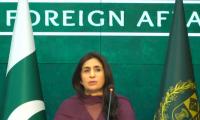The chaotic situation in Karachi during the torrential rains revealed how we mismanage our mega cities by allowing them to grow haphazardly.
This dreadful situation in overpopulated cities emerges only during emergencies such as unusual rains or earthquakes for which the city administrations are usually unprepared. TV networks and the print media amply highlighted the ugly situation of failing civic amenities. Were Karachi not as overgrown in population as it is, the situation would have been quite different.
Not learning from the situation in Karachi, the Lahore Development Authority has removed the restriction of limiting vertical construction of buildings to a certain level. In its quarter page advert, a ten marla plot can have four floors and, progressively, a twelve kanal plot will have no limit of floors on it. In other words, the building on it can touch the clouds if the owner so desires.
Before allowing to proceed in vertical construction, the LDA should have taken into account how its decision will impact the population density in the sprawling metropolis. Would the sewage system and other civic facilities of the city be able to cope up with the vertical expansion of buildings what with the large number of people inhabiting them?
How do the developed countries organise and plan the future of their people? The population density in our country stands at 281 people per sq kilometre while in Australia it’s 3.14 per sq kilometre. Despite having such low density of population, the Australian government has decided to disallow migrants to settle down in its two large cities – Sydney and Melbourne. Wisely, the Australian government encourages migrants to settle in less populated cities, called the regional areas.
We may not have land mass as huge as Australia has, but we could plan to establish new cities instead of overburdening the existing ones. For instance, new cities and industrial towns could be established along motorways running from Peshawar to Karachi. These cities could have access to the motorway but not be located too close to it. Otherwise, the motorways too could turn into continuous bazaars, as the scene on the GT Road now presents.
A traveller on the GT Road hardly realises when one city ends and the other begins. But my good friend Iftikhar Kayani still prefers travelling by the GT Road since he thinks there’s no fun if one doesn’t stop at every dhaba for khabah on the way.
One way to establish a new industrial city is to give incentives to entrepreneurs by providing electricity and gas at concessional rates. Many sites in Punjab exist where such cities could be established. A large tract of land ahead of Bhera between River Jehlum until the salt range mountains is rocky and almost infertile. The site has water, electricity and motorway to make it an ideal industrial city.
Politicians who create landmarks – motorways and transport networks – go down in history. The present political leadership may consider establishing new industrial zones since industrialisation leads to urbanisation and creates employment opportunities. Similarly, setting up universities including residential facilities for students and the faculty members away from main urban centres could help develop into new cities.
There are many universities in the US around which cities developed with time. Even University Town in Peshawar enjoys such a reputation, not to mention the prestigious Ghulam Ishaq Khan Institute of Engineering Sciences and Technology in Topi. Topi was an insignificant small town before the GIK Institute was established. Whenever new projects are set up in virgin territory, related businesses such as building contractors, retailers and other service providers make a beeline for exploring new opportunities.
About forty years ago, Thokar Niaz Beg was a desolate little place with some shops and tea stalls. Now it’s swarming with people and presents a scene of unmanaged traffic round the clock. Even old residents of this area, including yours truly, find it hard to negotiate the unruly traffic. Hence, instead of turning the overpopulated cities into concrete jungles by allowing construction of skyscrapers, it’s time to establish new cities.
The writer is a freelance columnist based in Lahore.
Email: pinecity@gmail.com
A woman walks past a building of the International Monetary Fund. — AFP/FileThe annual and spring meetings of the...
Late Benazir Bhutto's daughter Asifa Bhutto Zardari addresses the Christian community in Bihar Colony on January 23,...
Representational image. — PexelsWater is an important scarce natural resource that is required for several everyday...
Pakistani employees of online marketplace company Kaymu at work in Karachi. — AFP/FileThe true spirit of development...
India uses Afghanistan as a backstage area to carry out terrorist attacks against Pakistan
Another report by the Pakistan Institute of Peace Studies states that 78 per cent of attacks have been carried out by...







